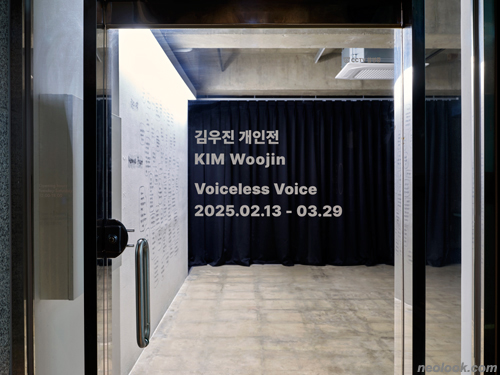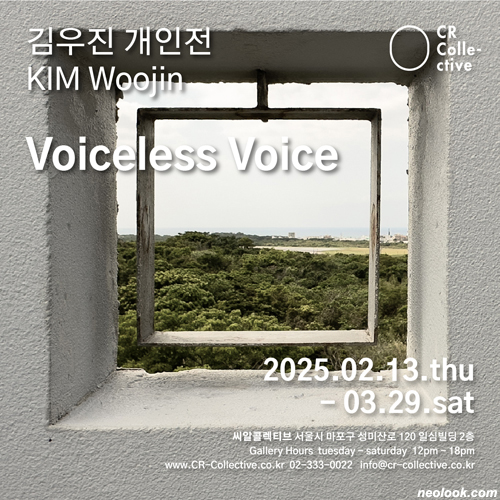- ● homepage
- ● archives
- ● restoration
- ● books
- ● big banners
- ● post board
- ■ neo's search
- ■ about us
- ■ 게재방법 안내
- 개인정보처리방침

- [email protected]
- Tel. 02_335_7922
- Fax. 02_335_7929
- 10:00am~04:30pm
- 월요일~금요일
- 3/3(월) 대체공휴일

Voiceless Voice
김우진展 / KIMWOOJIN / 金佑珍 / video 2025_0213 ▶ 2025_0329 / 일,월,공휴일 휴관
● 위 이미지를 클릭하면 네오룩 아카이브 Vol.20221119i | 김우진展으로 갑니다.
초대일시 / 2025_0213_목요일_05:00pm
주최 / 재단법인 일심 후원 / 한국문화예술위원회
관람시간 / 12:00pm~06:00pm / 일,월,공휴일 휴관
씨알콜렉티브 CR Collective 서울 마포구 성미산로 120 일심빌딩 2층 Tel. +82.(0)2.333.0022 cr-collective.co.kr
김우진 작가는 그동안 하나의 국가, 사회, 민족이 권력과 체제 유지를 위한 이데올로기적 장치들로 개인의 사적이고 일상적인 영역, 특히 기후 위기를 초래한 인간은 멸종 위기의 야생생물 뿐만 아니라 사적 일상과 문화, 나아가 역사와 세계관을 담고 있는 소수언어의 멸종도 가속화하고 있다. 글로벌화나 포스트 후기식민주의라는 거대담론을 거론하지 않아도 우리는 멸종을 초래하고 있는 현 지구촌에 대한 불만과 좌절, 그리고 불안을 감당하고 있는 것이다. 김우진은『Voiceless Voice』 전시를 통해 다양한 언어로 전 세계가 소통하고 이해를 넓혀 나가길 조심스럽게 촉구하고 하고 있다. 이번 전시는 김우진의 「메모리즈 프로젝트」의 한 챕터를 마무리하고 새로운 챕터로 확장하는 단계적 의미를 가진다. 작가는 언어의 멸종에 관한 프로젝트를 시작하면서 이데올로기에 잠식되지 않기 위해 스스로를 의심하고 조심스럽게 바깥을 사유하고자 노력해왔다. 그의 노력은 이번 전시에서 마인드맵과 「무너지는 기호들 Collapsing Sign」을 통해 엿볼 수 있고, 아이디어의 관계망들과 함께 그동안 인터뷰 자료들을 아카이빙 한 「완벽한 결말의 시작」 시리즈를 전시한다. 또한 전시장을 커튼이 내려진 극장으로 전환하여, 「한국어 받아쓰기 시험_다음을 듣고 따라 쓰시오(2채널 버전)」, 「그리고 나는 짧은 연극을 만들기로 결심했다_Part U」(이하 Part U), 「유령과 바다, 그리고 뫼비우스」 이 세 작업을 순차로 스크리닝 한다.
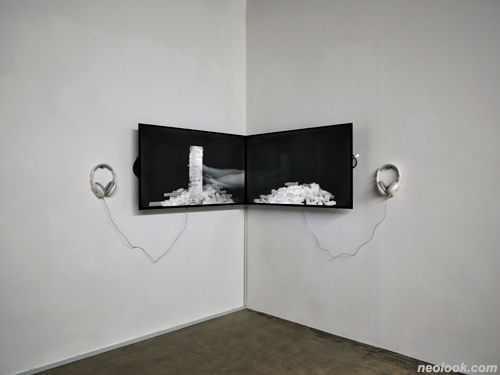
- 김우진_무너지는 기호들 Collapsing Sign_2채널 영상설치_00:05:21_2018

- 김우진_메모리즈 프로젝트_마인드맵 월드로잉 Memories Project_Mind Map_벽에 연필 드로잉_가변설치_2025
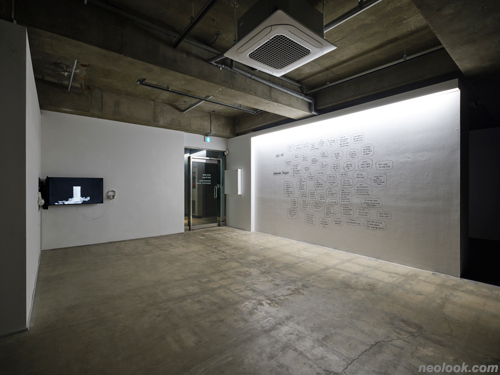
- 김우진_Voiceless Voice展_씨알콜렉티브_2025
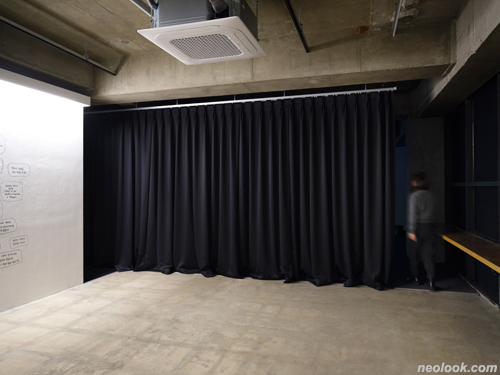
- 김우진_Voiceless Voice展_씨알콜렉티브_2025
차와 다과상이 놓인 무대로 손님역할의 배우들이 입장한다. 손님을 초대한 작가 김우진은 일본의 오키나와 언어인 우치나구치의 사라짐을 추적하며 그동안 수집한 다양한 자료와 관련자 인터뷰내용을 따라 문답형식으로 쓰여진 시나리오를 배우들에게 전달한다. 이렇게 촬영된 영상 속 손님들은 두상 아래부분 몸의 행위만 보이는 낯선 프레임안에서, 그 누구도 아닌, 또는 나를 포함한 누구도 될 수 있는 익명의 이름으로 등장한다. 반면 화자는 배우가 아닌, 우치나구치의 기억을 가진 실제 인터뷰 대상자의 음성으로 대체되어, 언어의 멸종과정과 함께 당시 이데올로기의 횡포와 차별화에 대한 생생한 공동의 기억을 끄집어낸다. 영상은 인터뷰가 진행됨에 따라 사실과 허구의 경계가 모호해지면서 아주 조금씩 흑백으로 전환되는데, 우치나구치 사멸을 묘사하는 부분부터는 완전히 흑백이 된다. 영상의 내러티브는 외형상 연극적인 형식을 차용하지만 인터뷰 내용과 발화자의 음성 및 언어가 실제 사건의 기억을 바탕으로 한만큼 직관적이고 사실적이다. 그리고 마지막으로 작가는 손님들에게 "우치나구치로 당신의 오늘 하루를 얘기해주세요."라고 요청한다. AI 번역기로 번역되지 못한 발화된 답변들은 그저 소리나는 음가로만 결과값을 보여주며 연극과 함께 영상 「Part U」는 마무리된다.
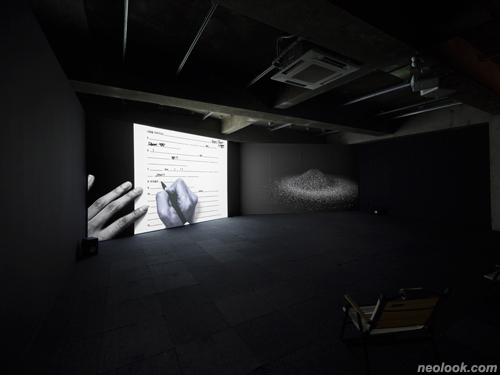
- 김우진_한국어 받아쓰기 시험_다음을 듣고 따라쓰시오 Korean Dictation Test_You Will Have to Answer Questions What You Hear_4채널 영상설치, 2채널 변형버전_00:05:26_2019
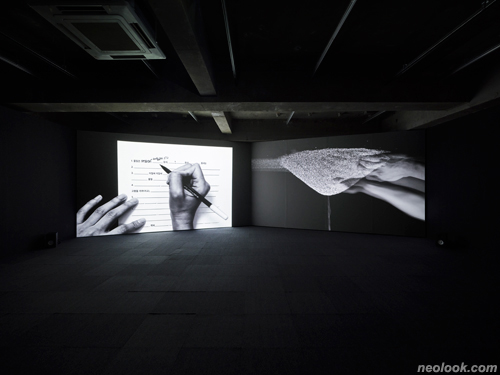
- 김우진_한국어 받아쓰기 시험_다음을 듣고 따라쓰시오 Korean Dictation Test_You Will Have to Answer Questions What You Hear_4채널 영상설치, 2채널 변형버전_00:05:26_2019
「Part U」에서 사건의 공간이 되는 오키나와는 19세기에 일본에 병합되고 일본의 국가 건설 과정에서 언어와 문화를 강요당하면서 무시와 차별을 당해오다가, 1945년 태평양전쟁 시기에는 전장으로 활용되면서 수많은 민간인이 희생당했다. 2차대전 후 점령군인 미국의 수탈과 파괴가 자행되었으며, 1972년 일본으로 반환후에도 군사기지 범죄와 환경파괴로 아픔의 역사를 가지고 있다. 특히 이 시기엔 일본과 미국 사이에서 언어탄압과 무작위 살상, 그리고 강제집단사 같은 참극이 일어난다. 이쯤 되면 우리는 어떤 기시감을 느끼게 될지 모른다. 맹목적인 국가 이데올로기가 자리한 사회에서 참담한 제주 4.3 사건과 함께 제주어의 사멸과정을 떠올리게 될지 모른다. 작가는 제주 해녀와 고유한 직업문화, 그리고 제주어의 사라짐을 등장 해녀들이 한 명씩 페이드아웃 되어 사라지는 영상언어로 내러티브를 극대화하였다. 그리고 작가는 동아시아의 또 다른 국가인 홍콩에서도 상상적 관계의 표상으로서 이데올로기 아래 홍콩어의 사멸화와 통제가 진행되고 있음을 목도한다. 게다가 향후 프로젝트로서 디지털 언어의 멸종을 추적하면서 언어 다양성의 감소에서 불거지는 부정적 문제를 환기하고 있다. 김우진은 "연구논문에 따르면, 전 세계적으로 7000개 이상의 언어가 존재하지만 그 중 극소수만이 성공적으로 디지털화 되었거나, 그 과정에 있다고 한다. 정보를 얻기 위해 힘을 가진 언어들을 습득하고 사용하는 사이, 디지털화에 실패한 언어들은 현실세계에서도 소멸이 가속화되고 소수 언어로 작성된 유의미한 디지털 정보도 사라지게 된다"고 한다.
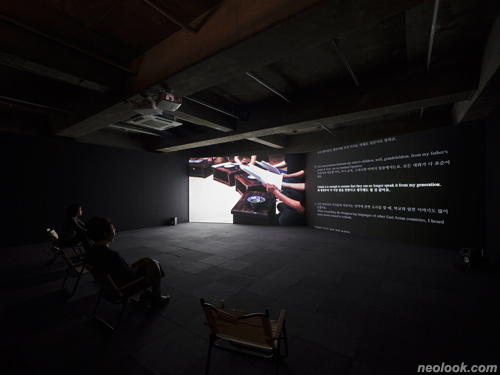
- 김우진_그리고 나는 짧은 연극을 만들기로 결심했다_Part U And I Decided to Make a Short Play_Part U_2채널 영상설치_00:21:10_2024~5
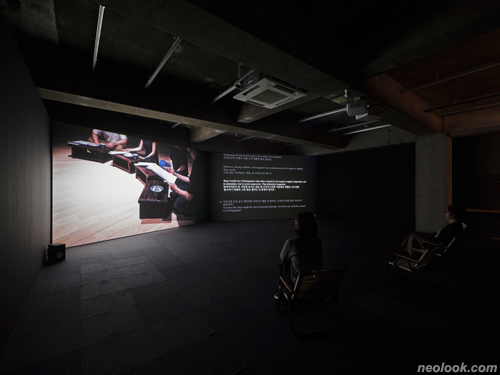
- 김우진_그리고 나는 짧은 연극을 만들기로 결심했다_Part U And I Decided to Make a Short Play_Part U_2채널 영상설치_00:21:10_2024~5
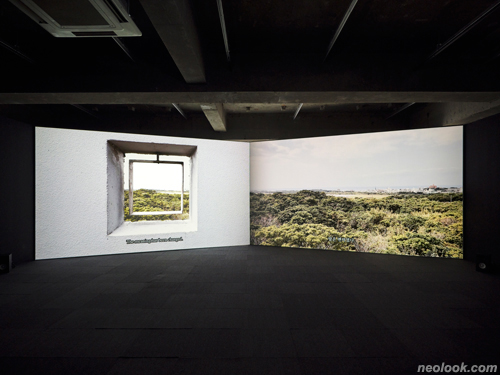
- 김우진_그리고 나는 짧은 연극을 만들기로 결심했다_Part U And I Decided to Make a Short Play_Part U_2채널 영상설치_00:21:10_2024~5
「Part U」는 2채널 비디오 신작으로, 전반부는 오키나와 거리를 훑으면서 작가의 독백과도 같은 시구로부터 시작한다. 언어의 멸종과 함께 사라진 고유한 문화와 지적 역사를 "큰 구멍이 그 사이를 가로지르는 어떤 극"으로 상징화하면서, 미처 말할 수 없고, 알지 못한 자들이 책임을 통감해야 하는 공통의 감각으로서 행동을 촉구하고 있는 듯하다. 구전언어의 멸종이라는 난제에 봉착하여 관련 인터뷰 대상자들을 물색하고 아시아권역을 로케이션으로 잡는 현장리서치와 아카이빙 과정은 비록 고되었으나, 축적된 정보는 작가에게 적극적으로 의도와 자신감을 드러내고 정서적 유사성을 담보한 실천과 행동의 드라이브를 걸도록 한다. 작가는 영상의 한쪽은 극장의 무대로, 다른 한쪽은 관객이 대본을 텔레프롬프터 형식으로 읽을 수 있게 배치하여, 언어의 멸종이라는 사건이 연극적 허구 같은 사실로 교차하고 있다. 작가는 디지털 과정에서 측정언어가 사라짐을 시각적으로 표현하기 위해 프로젝트 전 과정에서 AI번역기 [ChatGPT 3.5, 딥엘(Deepl), 파파고, 구글 번역기]를 사용하였다고 한다. "작업을 준비하는 과정에서 아이누어, 우치나구치, 그리고 제주어 같은 소멸을 인식한 언어들의 경우 사회적인 보존 노력과 복원작업이 시작하는 단계이고, 일부 디지털화하는 노력이 이루어지고 있기에 그나마도 미약하게나마 AI는 언어의 존재를 인식한다." (작가 노트에서)
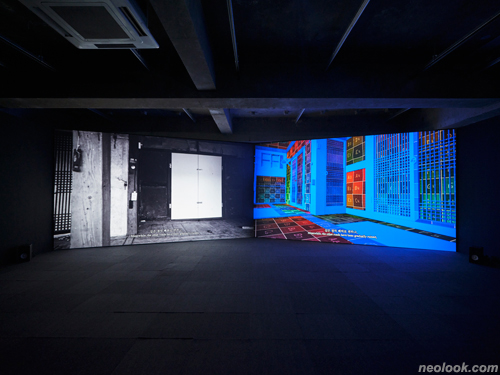
- 김우진_유령과 바다 그리고 뫼비우스 The Ghost, Sea and Möbius Loop_2채널 영상설치_00:08:59_2022
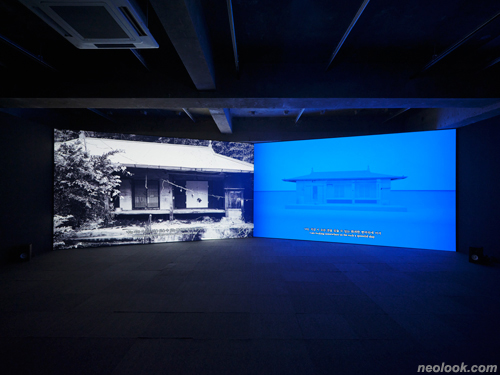
- 김우진_유령과 바다 그리고 뫼비우스 The Ghost, Sea and Möbius Loop_2채널 영상설치_00:08:59_2022
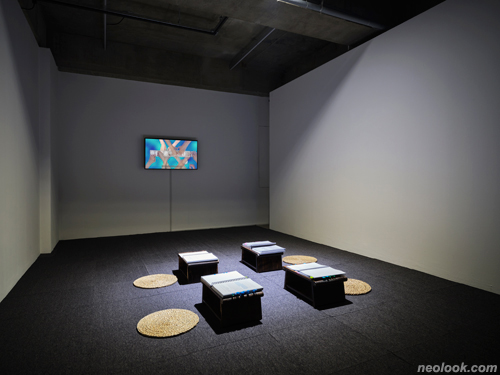
- 김우진_Voiceless Voice展_씨알콜렉티브_2025
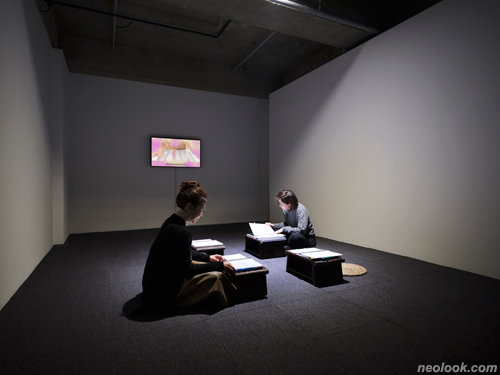
- 김우진_Voiceless Voice展_씨알콜렉티브_2025
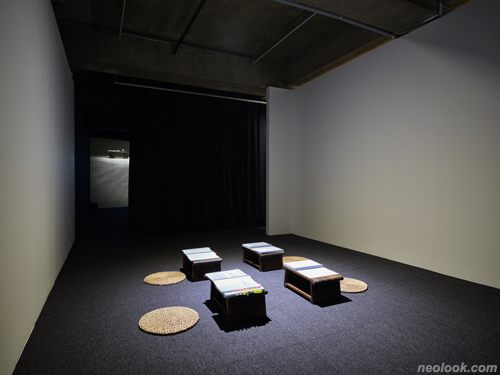
- 김우진_Voiceless Voice展_씨알콜렉티브_2025
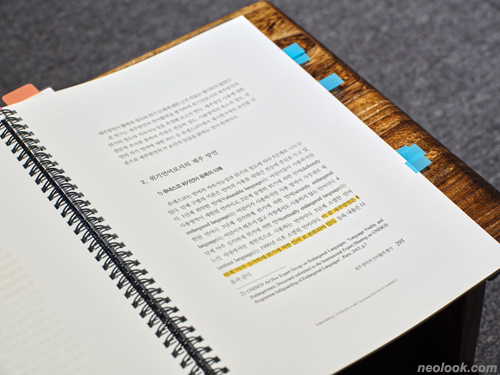
- 수집한 인터뷰와 자료들 Collected Interviews and Reading Meterials
김우진 작가는 그동안 하나의 국가, 사회, 민족이 권력과 체제유지를 위한 이데올로기적 장치들로 개인의 사적이고 일상적인 영역, 특히 학교나 가정교육 속에서 언어를 강제하는 것에 관심을 가지고 메모리즈 프로젝트(Memories Project)를 진행해왔다. 그는 아시아 지역 레지던시 프로그램에 참여하면서 그곳에서 발생되고 있는 유사한 사회현상과 함께 언어의 사라짐에 대해 다양한 관련자 인터뷰와 자료 조사를 지속해왔다. "(소멸위기 언어인) 아이누어와 우치나구치에 대해, 나아가 제주어를 비롯하여 아시아의 언어에 대해 조사하고 인터뷰를 수집하는 과정에서 나는 그들의 이야기, 역사, 현재 상황을 과연 내가 진정 이해할 수 있을지 끊임없이 의문이 들었다. 극장 그리고 무대 위 연극 구조를 드러내는 것을 통해 우리가 알고 있다고 생각하는 세계가 얼마나 제한적인지, 그리고 그 너머에 있는 더 큰 부분을 우리가 얼마나 인식하지 못하고 있는지를 드러내고자 하였다. 이러한 무지 혹은 무관심으로 인해 어떤 세계들은 사라지고 있다." (작가 노트에서) ■ 씨알콜렉티브
Humans, who have caused the climate crisis, are accelerating not only the extinction of endangered wildlife but also minority languages that contain private life, culture, history, and worldviews. Even without mentioning grand discourses like globalization or post-postcolonialism, we are bearing the dissatisfaction, frustration, and anxiety about the current global village that is causing these extinctions. Through this exhibition "Voiceless Voice," Woojin Kim cautiously urges for global communication and broadened understanding through diverse languages. This exhibition marks the completion of one chapter of the "Memories Project" concerning the disappearance of languages and holds significance as a step toward expanding into a new chapter. Since beginning this project, Kim has tried to doubt herself and carefully think from outward world to avoid being consumed by ideology. Her efforts can be glimpsed through the mind map and "Collapsing Sign" in this exhibition, and are revealed through the "Beginning of a Perfect Ending" series, which archives interview materials along with networks of ideas. Additionally, by transforming the exhibition space into a theater with lowered curtains, she sequentially screens three works: "Korean Dictation Test_You Will Have to Answer Questions What You Hear (2-channel version)," "And I Decided to Make a Short Play_Part U" (hereafter "Part U"), and "The Ghost, Sea and Möbius Loop." ● The actors playing the role of guests enter a stage set with tea and refreshments. The host, artist Woojin Kim, presents the actors with a script written in a Q&A format, based on various materials and interview content. She has collected while tracking the disappearance of Uchinaguchi, the indigenous language of Okinawa, Japan. In the filmed footage, the guests appear in an unfamiliar frame showing only their bodies below the head, appearing as anonymous figures who could be anyone or no one, including oneself. In contrast, the speaker is not an actor but is replaced by the actual voices of interview subjects who have memories of Uchinaguchi, drawing out vivid collective memories of the ideological oppression and discrimination along with the process of language extinction. As the interview progresses, the video gradually transitions to black and white, becoming completely monochrome when describing the death of Uchinaguchi. While the video's narrative adopts a theatrical format on the surface, it remains intuitive and factual as the interview content, speaker's voice, and language are based on memories of real events. Finally, Kim asks the guests, "Please tell me about your day in Uchinaguchi." The spoken responses, which cannot be translated by AI translators, are shown only as phonetic values, and with this, the new video work "Part U" concludes. ● In "Part U," Okinawa, which serves as the setting for these events, was annexed by Japan in the 19th century and suffered discrimination and disregard while being forced to adopt Japanese language and culture during Japan's nation-building process. During the Pacific War in 1945, it was used as a battlefield, resulting in numerous civilian casualties. After World War II, it endured exploitation and destruction under American occupation, and even after its return to Japan in 1972, it continues to bear a painful history of military base crimes and environmental destruction. Particularly during this period, tragedies such as language suppression, indiscriminate killing, and forced mass deaths occurred between Japan and USA. At this point, we might experience a sense of déjà vu. We might be reminded of the process of the Jeju dialect's extinction alongside the tragic Jeju April 3 Incident in a society dominated by blind national ideology. Kim maximized the narrative by using visual language showing Jeju haenyeo (female divers) and their unique occupational culture, along with the disappearance of the Jeju dialect, depicted through the gradual fade-out of the divers one by one. Kim observes the control and extinction of the Hong Kong language under ideology as representation of imaginary relationships in Hong Kong, another East Asian region. As a future project, Kim tracks digitally endangered languages while raising awareness about the negative issues arising from the reduction in language diversity. According to Woojin Kim, "Research papers indicate that while there are over 7,000 languages worldwide, only a very small number have been successfully digitized or are in the process of being digitized. While people acquire and use powerful languages to gain information, languages that fail to digitize are accelerating towards extinction in the real world, and meaningful digital information written in minority languages is also disappearing." ● "Part U" is a new 2-channel video work, with the first half beginning with verses that read like Kim's monologue while scanning the streets of Okinawa. By symbolizing the unique culture and intellectual history that disappeared along with language extinction as "a play with a big hole running through it," it seems to urge action for recognition and interest as a common sense of responsibility that those who couldn't speak and didn't know must feel deeply. Although the field research and archiving process of finding relevant interviewees and selecting Asian region locations while facing the challenge of oral language extinction was arduous, the accumulated information drives Kim to actively show intention and confidence, and to take action with emotional similarity of affect. Kim arranges one side of the video as a theater stage and the other side so that the audience can read the script in the teleprompter format, cross-editing how the event of language extinction intersects with theatrical fiction-like facts. He mentions using AI translators (ChatGPT 3.5, DeepL, Papago, Google Translator) throughout the entire project to visually express the disappearance of specific languages in the digital process. "In the preparation process, languages acknowledged to be facing extinction, such as Ainu, Uchinaguchi, and Jeju dialect, are at the stage of beginning social preservation efforts and restoration work. Due to ongoing digitization efforts, albeit limited, AI systems can recognize at least the existence of these languages, however minimally." (from the artist's note) ● Woojin Kim has been conducting the "Memories Project," focusing on how a nation, society, or ethnic group forces language in the private and daily spheres, especially in schools or home education, as ideological devices for maintaining power and systems. While participating in residency programs across Asia, she has continued to conduct various interviews and research about similar social phenomena occurring in these regions, along with the disappearance of languages. "Throughout my process of researching Ainu and Uchinaguchi, and further collecting interviews about Jeju dialect and other Asian languages, I constantly questioned whether I could truly understand their stories, histories, and current situations. By revealing the structure of theater and stage, I aimed to show how limited our perceived understanding of the world is, and how unaware we are of the vast realm that lies beyond it. Due to such ignorance or indifference, certain worlds are disappearing." (from the artist's note) ■ CR Collective
Vol.20250213a | 김우진展 / KIMWOOJIN / 金佑珍 / video

